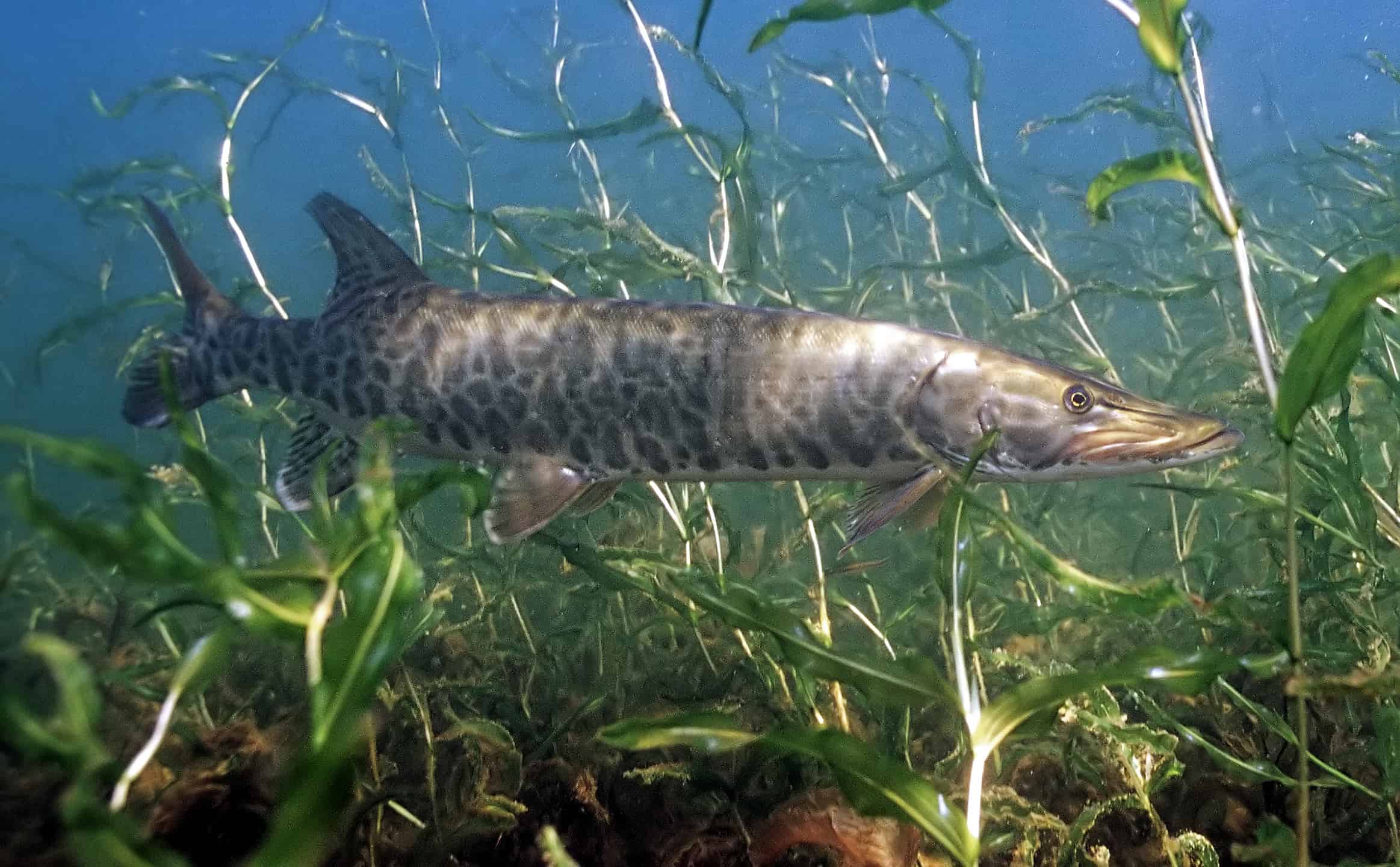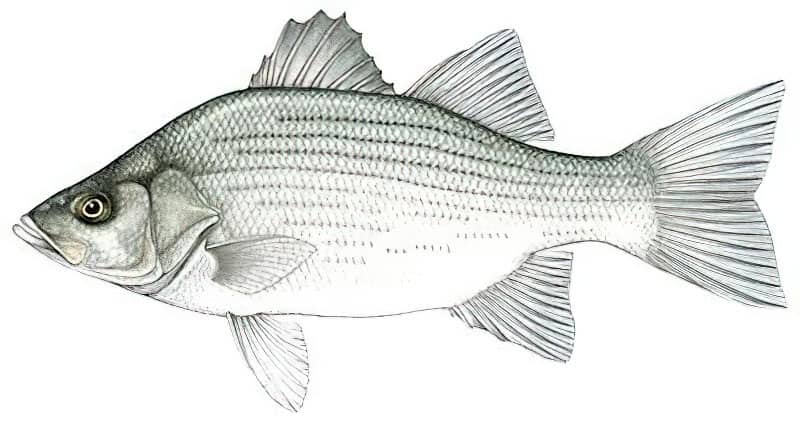You’ll find Lake St. Clair right between Ontario and Michigan. It is actually one of the Great Lakes, though at 430 square miles, it’s a fraction of the size of Lake Ontario, which is considered the smallest of the five Great Lakes everyone’s heard of. As a freshwater lake, Lake St. Clair is home to a variety of freshwater fish, and you can fish there year-round. Here are 15 fish you can catch.
1. Largemouth Bass

Here’s a close-up of the large mouth of the largemouth bass.
©Pierre Rebollar/Shutterstock.com
This popular game fish grows to around 10 pounds in the northern waters of Lake St. Clair, even though it can be over twice as heavy in its southern range. It has a robust, somewhat deep body, a greenish-gold head, and an olive-green to dark green back. Its sides are greenish yellow, with a long stripe from the eye to the tail. The first dorsal fin is spiny and is almost but not quite separate from the soft rays of the second dorsal fin. As its name states, this bass’s mouth is large, and its upper jaw extends beyond its eye.
You can catch largemouth bass using fly fishing, trolling, spinning or baitcasting. Since these fish are ambush predators, they’ll go for any sort of bait, natural or artificial.
2. Crappie
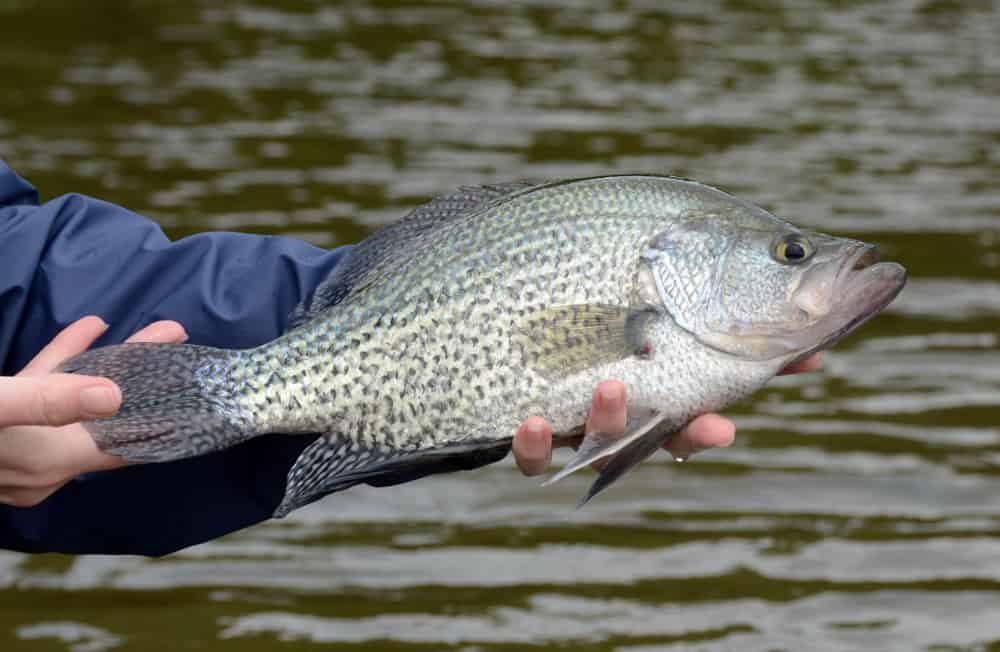
Black and white
crappies
live in the waters of Lake St. Clair.
©M Huston/Shutterstock.com
You’ll find two kinds of crappies in Lake St. Clair, the black and the white. The white crappie is a bit larger than the black crappie, and as its name suggests, it’s paler. However, it’s not so pale that it’s easy to tell the two fish apart. The best way is to count the spines in the fish’s first dorsal fin. The black crappie has seven or eight of these spines, while the white crappy has six. Black crappies also like the water they swim in to be clear, with lots of vegetation. White crappies are not that particular.
White and black crappies also have different reproductive strategies. Male black crappies build nests for females to lay their eggs in and protect them for a while. White crappies deposit their eggs on aquatic plants.
Both fish, members of the Pomoxis genus, are predators that eat smaller fish, insects, worms, grubs, and nymphs that fall into or live in the water. You can use these for live bait. Crappies are best caught with light tackle using the techniques of fly fishing, baitcasting, or float fishing.
3. Channel Catfish

You can find the channel
catfish
in Lake St. Clair, though it is also farmed.
©Aleron Val/Shutterstock.com
This fish can grow to nearly 4 feet in length and weigh up to 60 pounds. It has a slender body with a blue-gray back, light gray or silver sides with a scattering of dark spots, a white belly, and a deeply forked tail. Its upper jaw overhangs its lower which sports eight barbels. Channel catfish only reproduce when the temperature of the water reaches 75 degrees Fahrenheit or higher. Then, the male makes a nest for the female to deposit her eggs. Like the crappie, he’ll guard the eggs for a while.
If you go shopping for catfish nuggets, they most likely come from the channel catfish, since it’s a very popular farmed fish. If you want to catch it yourself, experts recommend float fishing, freelining, legering, or spinning with artificial lures. Channel catfish will grab on to anything, even a naked hook, but they really go for bait with a strong smell. This includes somewhat rotten meat, fish guts, and even slivers of perfumed soap.
4. Bluegill Sunfish
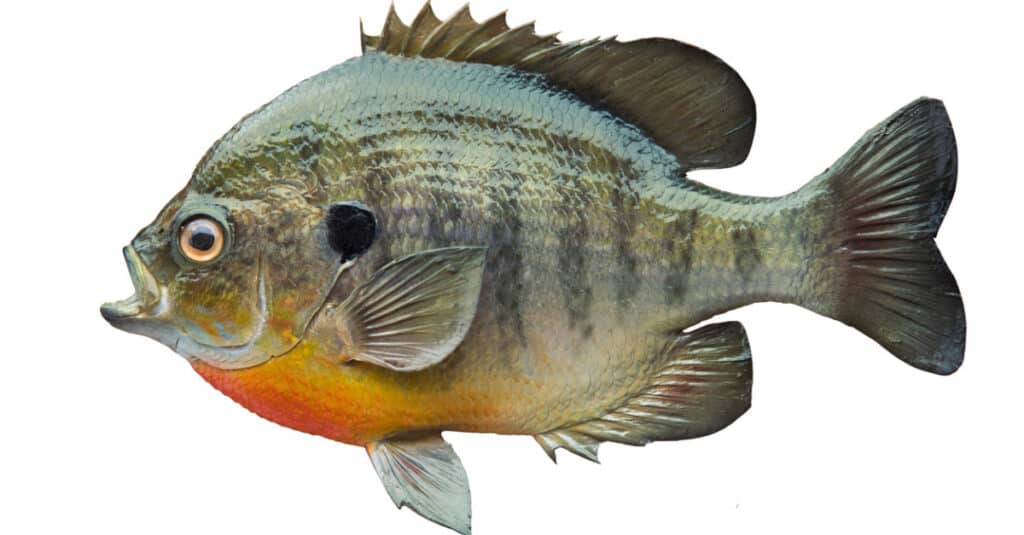
The opercular flap on this bluegill is black.
©iStock.com/Willard
Like the crappie, the bluegill is a popular panfish. This is a fish that people like to cook and eat after they’ve caught it but is too small to be considered a proper gamefish. This little fish lives among the quiet aquatic plants in Lake St. Clair and usually grows to only about four ounces, though large individuals can grow to 12 inches and weigh over four pounds. It has a compressed body with olive green fins, and its sides are olive green with dark bars and a brassy shimmer. It also has an opercular flap, which looks like a tab attached to the gill. The bluegill is the most common of the sunfishes and people raise it in ponds to serve as bait for even larger fish.
Fish for bluegills as you would for crappies. Use light tackle and live bait such as grubs or worms, or artificial bait such as spinners.
5. Yellow Perch
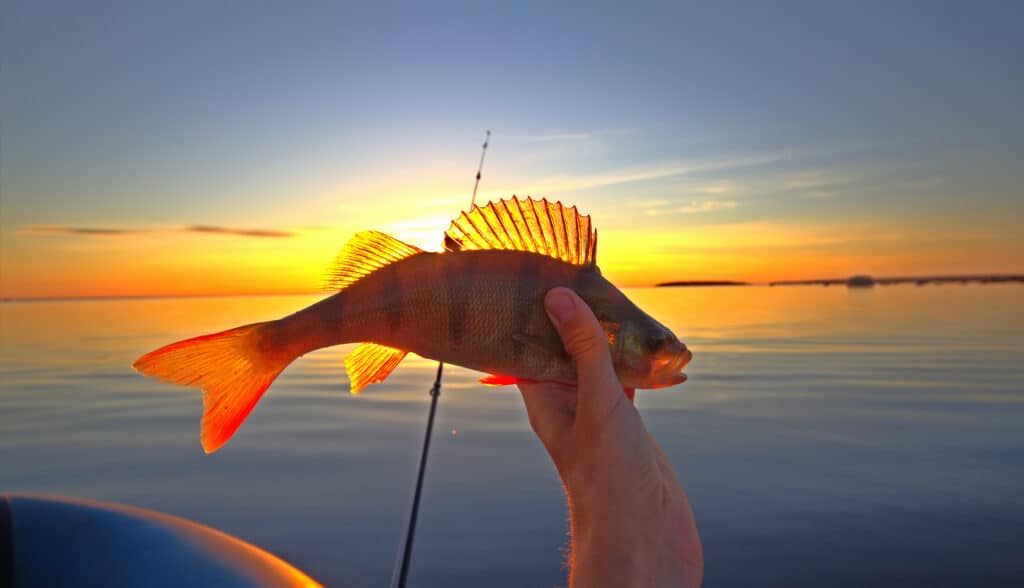
The yellow perch is a popular gamefish and good to eat.
©Maximilliam cabinet/Shutterstock.com
This fish is abundant in Lake St. Clair and likes to swim in schools. Because of this, it’s a popular gamefish that is allowed to be caught in great numbers. It is also delicious, even though it usually doesn’t weigh more than 4 pounds or grow more than 14 inches in length. As its name suggests, its color ranges from a bright yellow green to golden, with olive green to gray-green fins and gray-green bands on its sides. The fish lingers in deep water during the day but comes to the shallows at dusk and dawn to feed.
To catch yellow perch, use the techniques of float fishing, spinning, or legering. Use live bait, such as maggots and worms, or use spoons, plugs, and jigs for spinning.
Trout
Trout are some of the most popular game fish. They are basically cylindrical, mostly freshwater fish that are not salmon, even though they belong to the same family, Salmonidae. Trout have soft-rayed fins, an adipose, or fatty fin near the tail, and emarginate tail fins. They also have a swim bladder attached to their esophagus that helps them suck in and exhale air. The classic way to fish for trout is fly fishing. Making flies for this fishing technique has become an art form.
6. Brown Trout
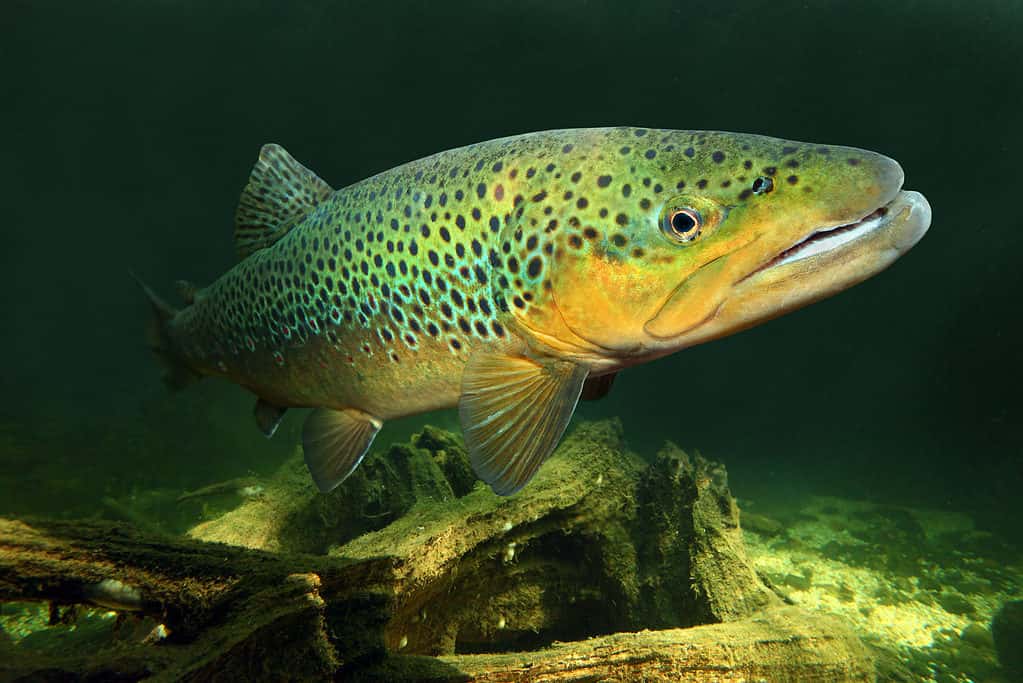
The body of the brow trout has black and red spots.
©iStock.com/abadonian
The brown trout is actually a transplant from Europe. Its appearance varies due to its genetics and its environment, but generally it is brownish with black and red spots. Some brown trout weigh about a pound while others can weigh as much as 30 pounds. Some of these fish are in fact cannibalistic and can be told from other brown trout by their hooked lower jaw. They are ambush predators and wait in the deeper waters of the lake for prey to swim by.
7. Cutthroat Trout
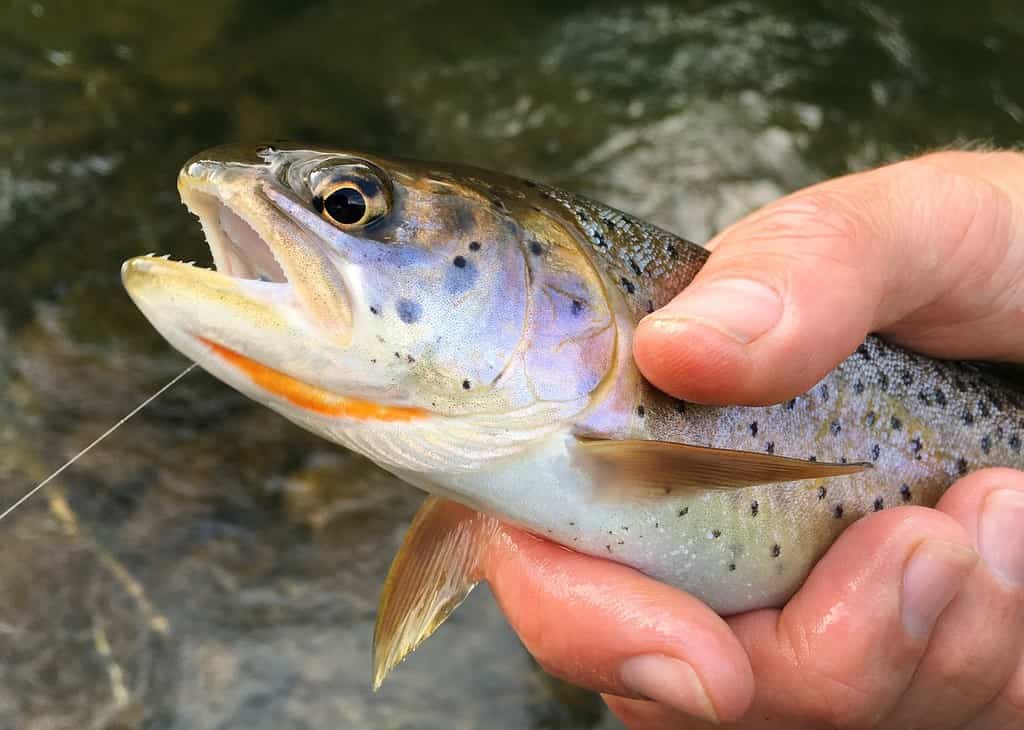
You can tell the cutthroat trout by the reddish slash beneath the jaw.
©Matt Jeppson/Shutterstock.com
The cutthroat trout gets its name because of the red line under its lower jaw, which makes it look like its throat has been slit. It is a slender fish, with a green back and dark freckles on its sides against an olive green or silver ground. These fish usually come in at five pounds, though they can be as heavy as 40 pounds.
8. Rainbow Trout
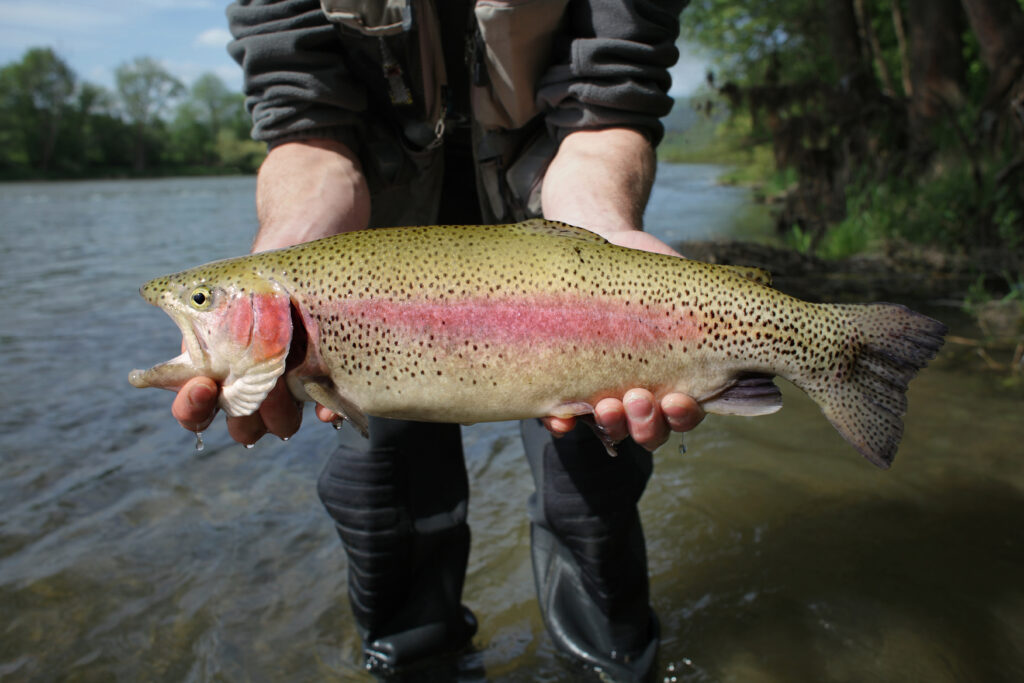
The rainbow trout gets its name for the pink band down its lateral line.
©pictoplay/Shutterstock.com
The rainbow trout is native to the Pacific Ocean’s colder tributaries and was brought east. There is no typical rainbow trout, but nearly all of the subspecies and races have a pink band down their lateral line and black speckles on their fins, sides, back, and tail. Though most weigh between two and four pounds, there have been rainbow trout caught that weigh more than 50 pounds.
9. Northern Pike
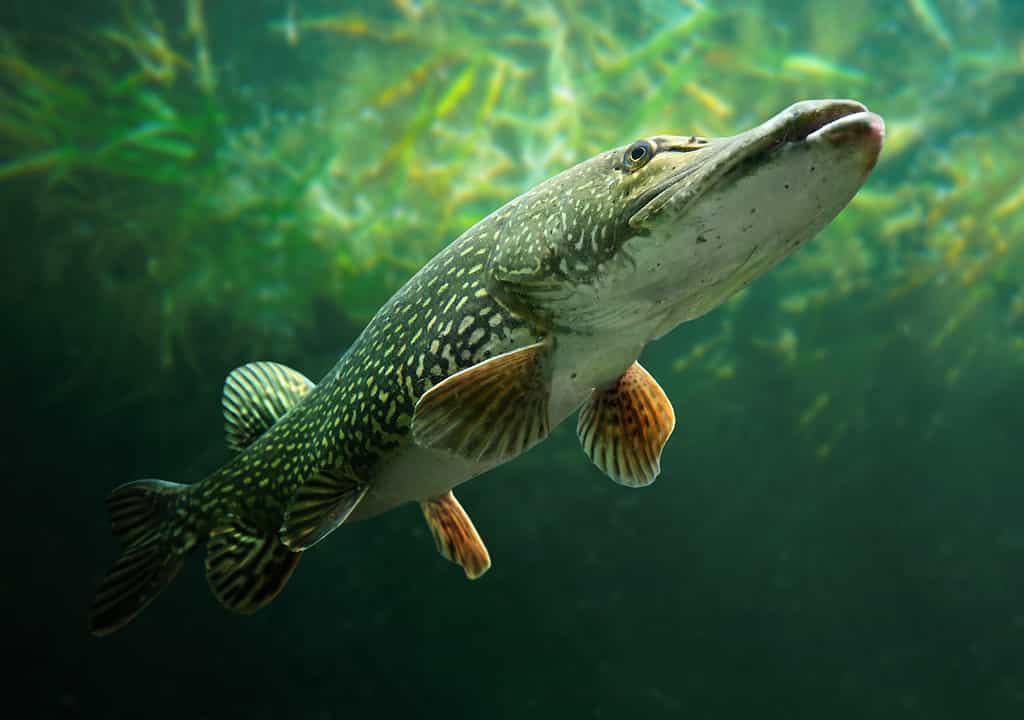
The northern pike is a ferocious predator.
©iStock.com/abadonian
The northern pike belongs to a family of aggressive predators whose long, slim bodies allow for bursts of speed as they ambush prey. Their usual prey is other fish, including smaller members of their own species, but pikes will eat just about anything that falls into the water, including rodents and birds. The structure of their skulls allows them to take unusually large prey, which they’ll swallow headfirst. Besides this, their mouths are full of sharp teeth, and they put up a fight when hooked. This makes some anglers wary of them. Most pikes weigh between 10 and 20 pounds, but fish as heavy as 75 pounds have been caught.
Northern pike are best captured through trolling, baitcasting, and spinning. Use large spoons, plugs, or spinners as artificial lures. Use minnows as live bait or cut up larger fish such as mackerels.
10. Walleye
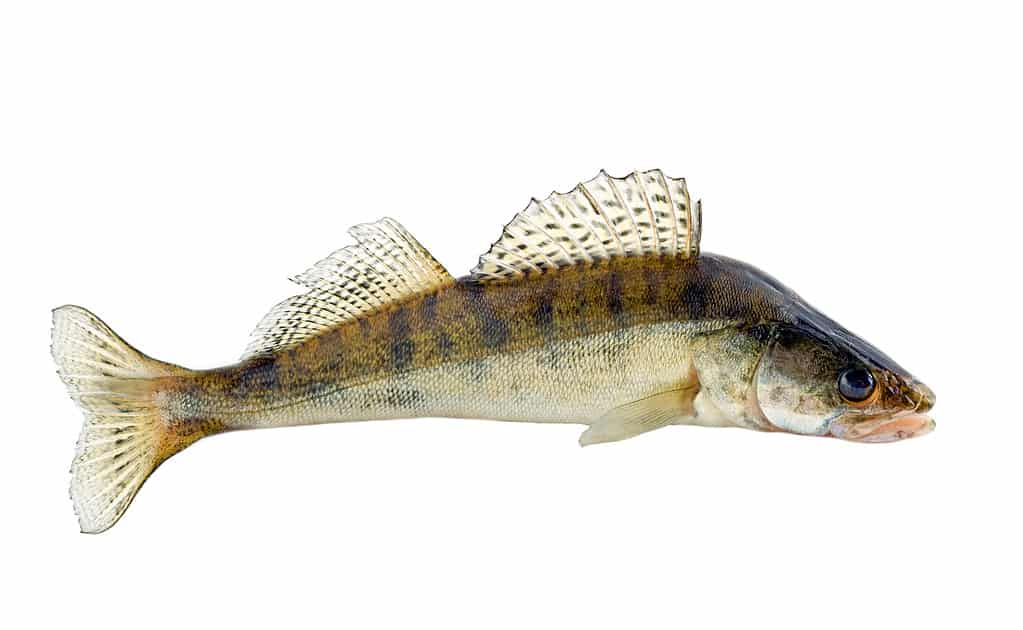
This fish’s eyes glow in the dark.
©iStock.com/Vladyslav Danilin
A cousin of the yellow perch, this fish gets its name because of its large, stary eyes, which glow in the dark when you aim a flashlight on them. The walleye can grow to over 3 feet long and weigh as much as 25 pounds. Its body is long, somewhat compressed, olive-brown or greenish yellow with dark mottling. It has a pale belly. The fish is also known for its canine teeth. It has two separate dorsal fins. The first is spiny, and the second is made of soft rays, as are the pelvic fins. The tail is softly forked. The best techniques for this fish are legering, spinning, and float fishing, and it prefers small fish such as minnows as live bait.
11. White Bass
This fish is a silvery white color, with unbroken stripes running down its side to its tail. It has large eyes, and a slightly superior mouth with teeth at the very back of its tongue. Most white bass grow to about 18 inches and weigh about 5.25 pounds. It’s a member of the sea bass family but travels in schools in fresh water. The white bass eats smaller fish as well as aquatic invertebrates such as crustaceans. The best techniques for catching this fish are spinning or fly fishing. Since white bass are predatory, they’ll take most live bait or lures.
12. European Carp
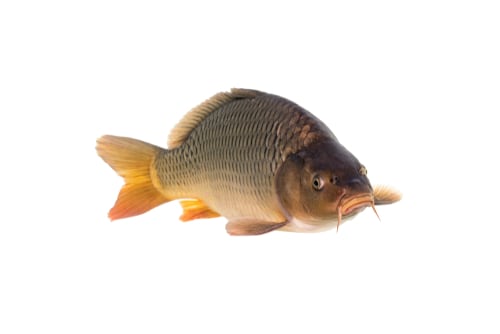
The European carp is a close relative of the goldfish.
©Carlos Aranguiz/Shutterstock.com
Like the brown trout, the European carp is native to Europe but was introduced into bodies of water like Lake St. Clair for fishing. Now, most unfortunately, it’s considered invasive, even as its conservation status is vulnerable. A European carp can produce a million eggs in a year, and even if one percent live to adulthood, it still means 10,000 more carp in the lake.
The European carp is a tough fish that can thrive in turbid water that has little oxygen. In oxygen-poor water, it will simply come to the surface and gulp in air. European carp are omnivorous and will eat both animal and plant life. They open their mouths and suck up their food even if it means destroying gravel beds and uprooting plants. The fish has a heavy, deep body, and though its head lacks scales, the rest of its body bears shiny scales in a distinctive pattern. The carp can grow to 5 feet in length, weigh 80 pounds and live about 20 years, though the oldest one caught was thought to be 38 years old.
Because the carp is so invasive there’s no limit to how many you can catch at Lake St. Clair. Ironically, fishermen find European carp so easy to catch that they don’t bother with it but go for more challenging fish. If you do want a European carp, the best techniques include float fishing, freelining, and legering. Just about anything will do for bait, including bread, cold cuts, and bits of potato.
13. Muskellunge

The muskie is even bigger than the northern pike.
©Engbretson, Eric / U.S. Fish and Wildlife Service, Public domain, via Wikimedia Commons – Original / License
The muskellunge, or “muskie” is in the same family as the northern pike and as such is a ferocious predator. It shares the pike’s torpedo-shaped body, flat head and mouth full of fangs. It’s a fast-growing animal that can grow to 6 feet and can sometimes weigh 100 pounds, though most are about 4 feet long and weigh between 15 and 36 pounds. This makes it larger than the northern pike. Another way to tell them apart is the patterns on their bodies. The northern pike has white spots and bars on its body while the muskellunge has dark bars and blotches. The lobes on the muskie’s tail are also more pointed than the lobes on the tail of the pike. Fish for the muskellunge the same way you would for the northern pike.
14. Yellow Bullhead

The bullhead likes to live in the murkier depths of the lake.
©Focused Adventures/Shutterstock.com
The bullhead is a catfish, and like many catfish it is an omnivore and a bottom feeder that likes the still or gentle waters of lakes like Lake St. Clair. Unlike most fish, its yellow-brown body is scaleless. It also has four pairs of white or yellow barbels around its mouth, an adipose fin near its tail fin, and dangerous spines at the edge of its dorsal and pectoral fins. The bullhead gets its name from its large head. It also has robust “shoulders” but its body tapers dramatically from there to its tail. This gives the fish the shape of a club when looking at it from above. Most yellow bullheads grow to around 18 inches in length and weigh about four pounds.
The yellow bullhead feeds at night and eats anything it can handle and digest. It is most easily caught through float fishing or legering and takes a great variety of bait, both natural and artificial.
15. Longnose Gar

Here’s a closeup of the long snout of the
longnose gar
.
©SunnyChinchilla/Shutterstock.com
This fish is noteworthy for its very long snout, which is twice as long as the rest of its head. The longnose gar can grow to 6 feet long and weigh more than 50 pounds. It has a cylindrical olive to brown body with dark spots on its side sand a white belly. You’ll find large, sharp teeth in its upper jaw and noteworthy, diamond-shaped scales. Though the fish puts up a fight when it’s hooked, it doesn’t make good eating, and its eggs are actually poisonous. Some anglers dislike it because it eats fish they like to catch such as sunfish and shad.
Longnose gar swim in small schools and can sometimes be found lying motionlessly just beneath the surface of the lake. When potential prey comes close, they sideswipe it then grab it in their long jaws. If you want to fish the longnose gar, the best techniques include hand netting, or spear and bow fishing.
Thank you for reading! Have some feedback for us? Contact the AZ Animals editorial team.

